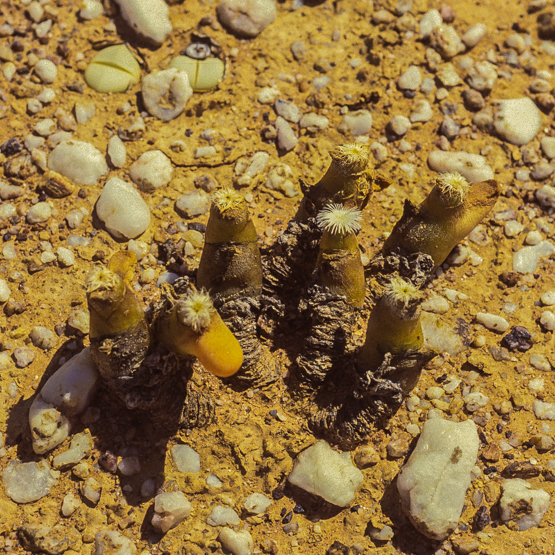
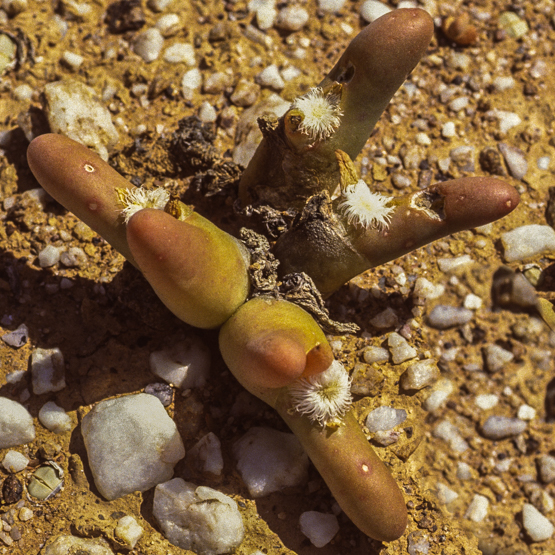
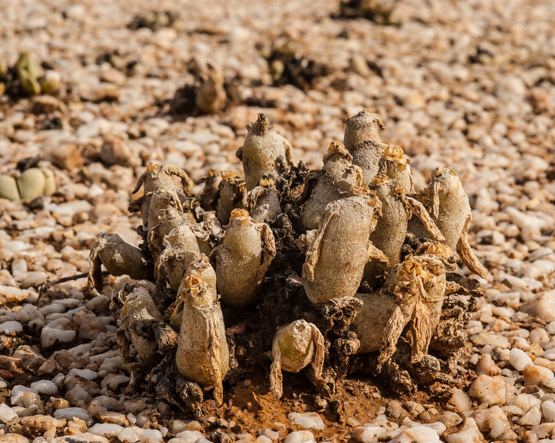
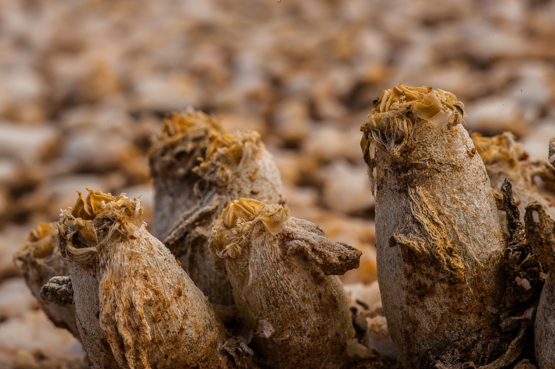
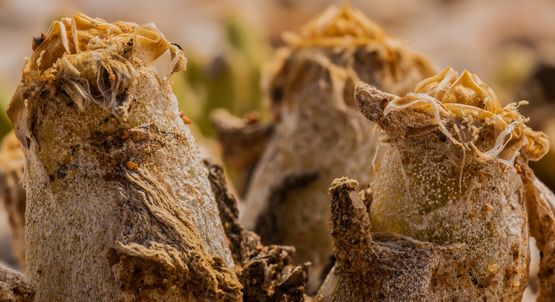





In my preceding post (https://enjoysucculents.wordpress.com/2015/11/01/conophytum-khamiesbergense/) I asked the readers’ opinion on the slide scans used there.
A big thank you to all who were kind enough to respond to that request (and I’m quite chuffed because all responses were positive). Being able to mix pictures that were taken digitally with ones that were scanned, gives me a lot more options for posts.
Today’s subject with its bizarre finger-and-thumb-like leaves is certainly one of the more peculiar succulents. One cannot help but feeling that some of this otherness is reflected in its taxonomic history:
The taxon* was described in 1789 as a Mesembryanthemum, in 1925 it was placed in a genus of its own (Dactylopsis) and in 1995 it was incorporated in Phyllobolus (only to be returned to Dactylopsis in 2006). In 2013 it was reinstated -together with many other species- as a member of Mesembryanthemum.
* Taxon is a term to refer to a taxonomic group or unit of any rank (a family, a variety or whatever -depending on the context).
The plants form clumps 10-20 cm tall and are heteromorphous (of variable shape): the first leaf of a growing period is long and the second short, giving the appearance of a “finger and thumb”.
They flower at the beginning of the resting period (November-December); the flowers stay open day and night for 3 weeks or even longer.
To see the plants in the wild, you have to go to the Vredendal/Vanrhynsdorp area of the Knersvlakte in Namaqualand, where they occur on shale covered with quartz pebbles.
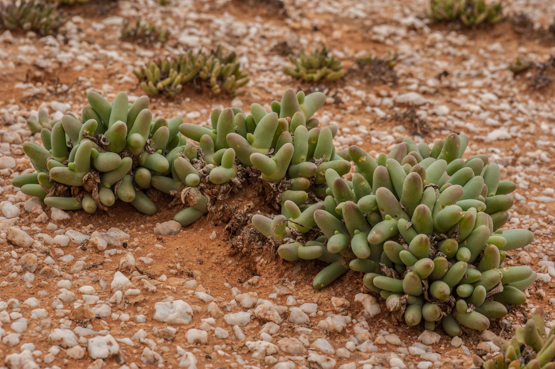
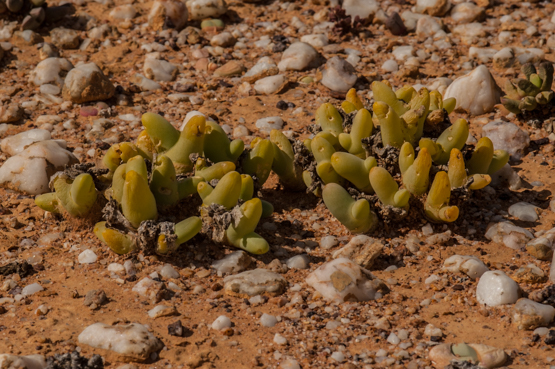
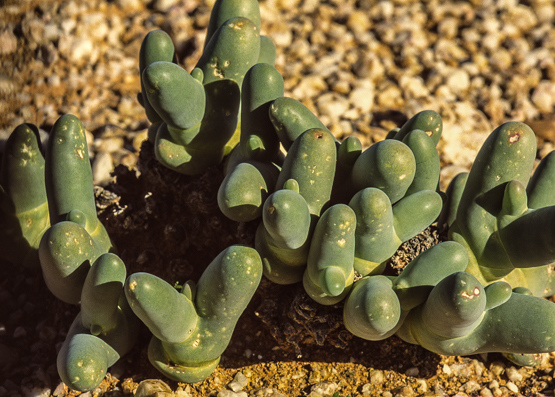
In my preceding post (https://enjoysucculents.wordpress.com/2015/11/01/conophytum-khamiesbergense/) I asked the readers’ opinion on the slide scans used there.
A big thank you to all who were kind enough to respond to that request (and I’m quite chuffed because all responses were positive). Being able to mix pictures that were taken digitally with ones that were scanned, gives me a lot more options for posts.
Today’s subject with its bizarre finger-and-thumb-like leaves is certainly one of the more peculiar succulents. One cannot help but feeling that some of this otherness is reflected in its taxonomic history:
The taxon* was described in 1789 as a Mesembryanthemum, in 1925 it was placed in a genus of its own (Dactylopsis) and in 1995 it was incorporated in Phyllobolus (only to be returned to Dactylopsis in 2006). In 2013 it was reinstated -together with many other species- as a member of Mesembryanthemum.
* Taxon is a term to refer to a taxonomic group or unit of any rank (a family, a variety or whatever -depending on the context).
The plants form clumps 10-20 cm tall and are heteromorphous (of variable shape): the first leaf of a growing period is long and the second short, giving the appearance of a “finger and thumb”.
They flower at the beginning of the resting period (November-December); the flowers stay open day and night for 3 weeks or even longer.
To see the plants in the wild, you have to go to the Vredendal/Vanrhynsdorp area of the Knersvlakte in Namaqualand, where they occur on shale covered with quartz pebbles.



With the many warts and teeth on the ends of their leaves, these fascinating plants are always immediately recognizable. They are so unlike other Conophytums that originally they were placed in a genus of their own: Berrrisfordia.
They form tight mats or cushions, with leaves to 1.5 cm long.
The whitish-pink to mauve flowers appear in late winter or early spring; they open in the morning and are scented of raspberries.
The species only occurs on granite domes in the highest part of the Kamiesberg in Namaqualand.
The pictures below are recent scans of slides that I made several years ago. The scanner I used before refuses to work with my current PC, so I decided to buy a new one for converting old slides that still might be put to good use.
After working on a picture for a long time, it often becomes very difficult to keep looking at the results in an objective way.
Therefore I would like to call in your help by letting me know if you think the quality of these pictures is on a par with what you have come to expect in this blog OR is at least good enough for the purpose.
If yes, wonderful; if no, I will just have to further improve my scanning skills!
The first picture -taken in August- shows that not only human beings like these plants. After winter rainfall, they are a juicy bite for hungry animals (in this case probably a tortoise).
The next four pictures were taken in October and November, when progressing heat and drought start discolouring the plants.
After summer the plants may look quite miserable (as shown in the last picture, taken in April).
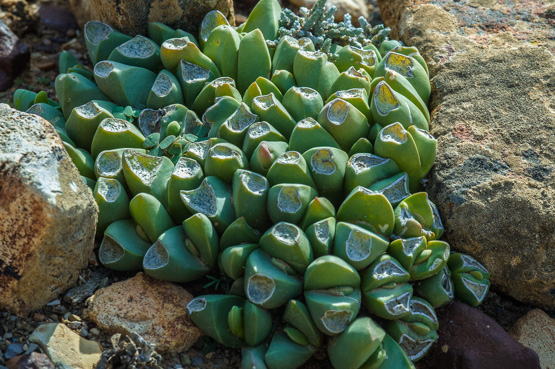
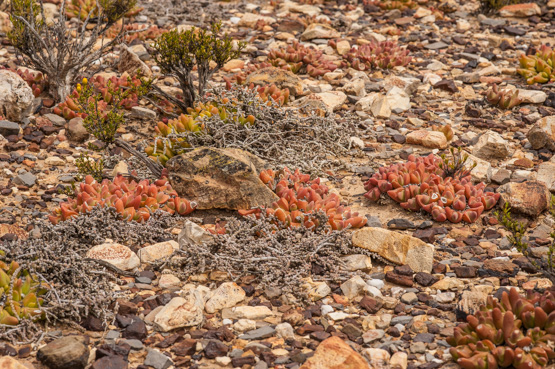
Both the genus name and the specific epithet are derived from the word gibba (hump, referring to the irregularly swollen leaves).
Plants of this species are sometimes locally abundant in the Western part of the Little Karoo and the Southwest corner of the Great Karoo (Ceres, Laingsburg, Montagu and Worcester), usually in pebbly shale or quartz patches.
They form more or less compact clumps up to 15 cm in diameter with a woody rootstock.
The pink to purple flowers are 2-3 cm in diameter and appear in early spring (August).
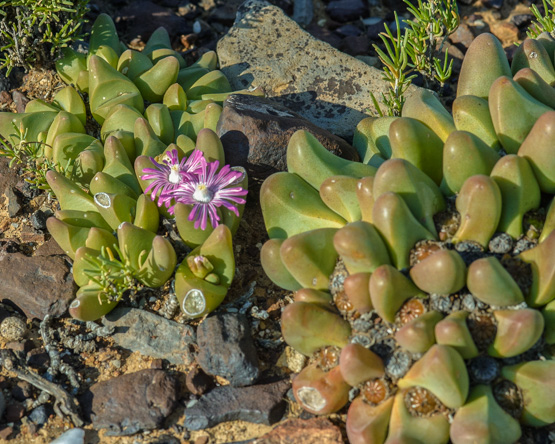
Here G. gibbosum is accompanied by Tanquana prismatica (on right)
It takes plants of this species 5-10 years to reach maturity and become columnar.
There are 2 subspecies, each with a number of local forms.
The plants are often locally abundant on gentle slopes and in depressions (often with quartz gravel); sometimes they also occur in shallow soil on rocky outcrops.
The flowers are white, pale yellow (often tinged red) or rarely almost red.
Subsp. columnaris is usually unbranched, with columns 2-3.5 cm wide, often as long as broad.
The inflorescence is swollen, rounded to flat and appears from May to September
The plants are monocarpic, which is another way of saying they die after flowering.
They are found in most parts of the little Karoo, the adjoining western Great Karoo and towards Calvinia.
Subsp. prolifera reaches a height of 3-10 cm when in flower and forms several short branches at the base. Often these branches easily break off and take root.
The inflorescence is more or less branched and appears from July to October. After flowering, the plants often regenerate from the lower branches.
This subspecies occurs in most parts of Namaqualand and adjoining areas of Bushmanland and southwestern Namibia.
The four pictures all show ssp. columnaris.